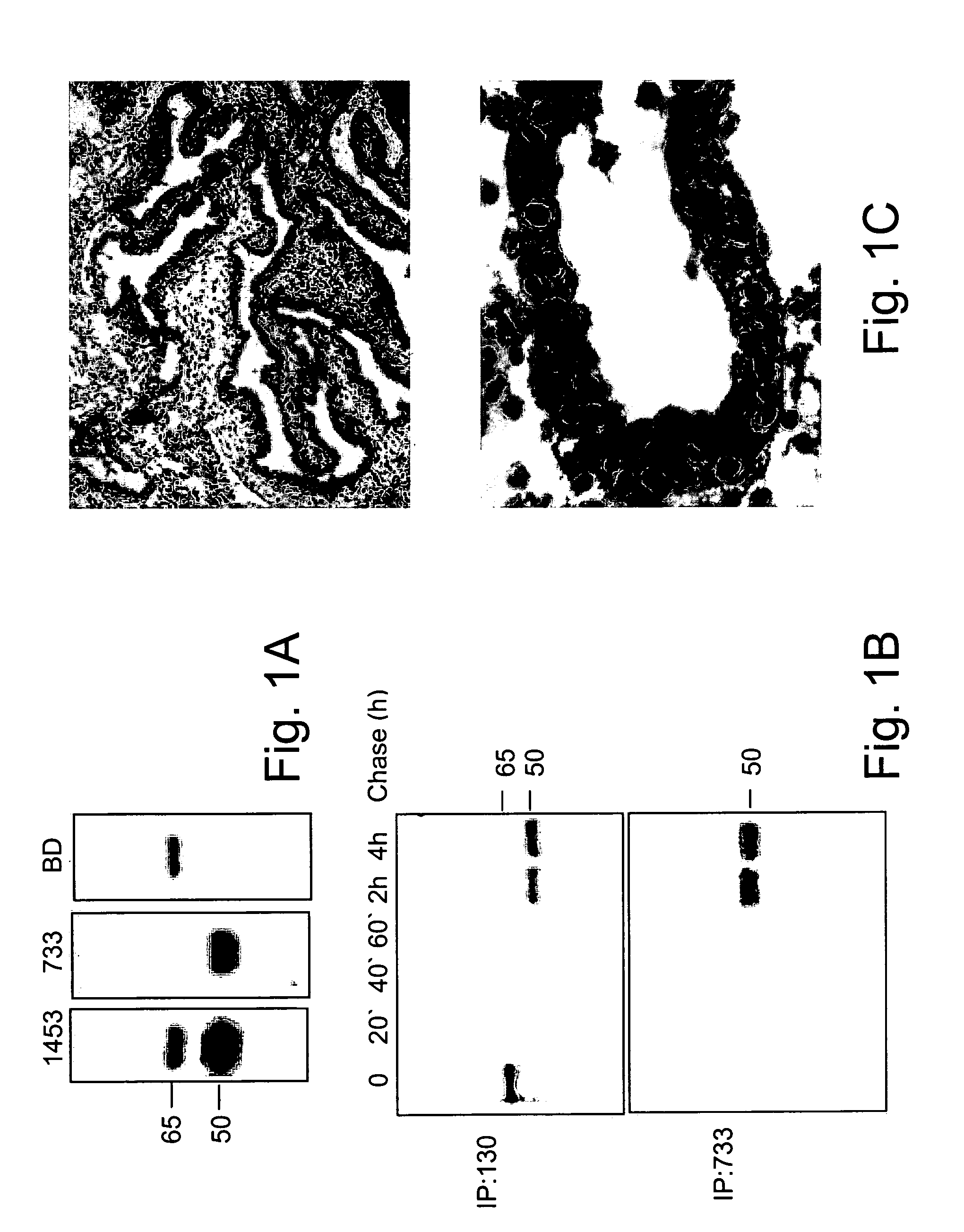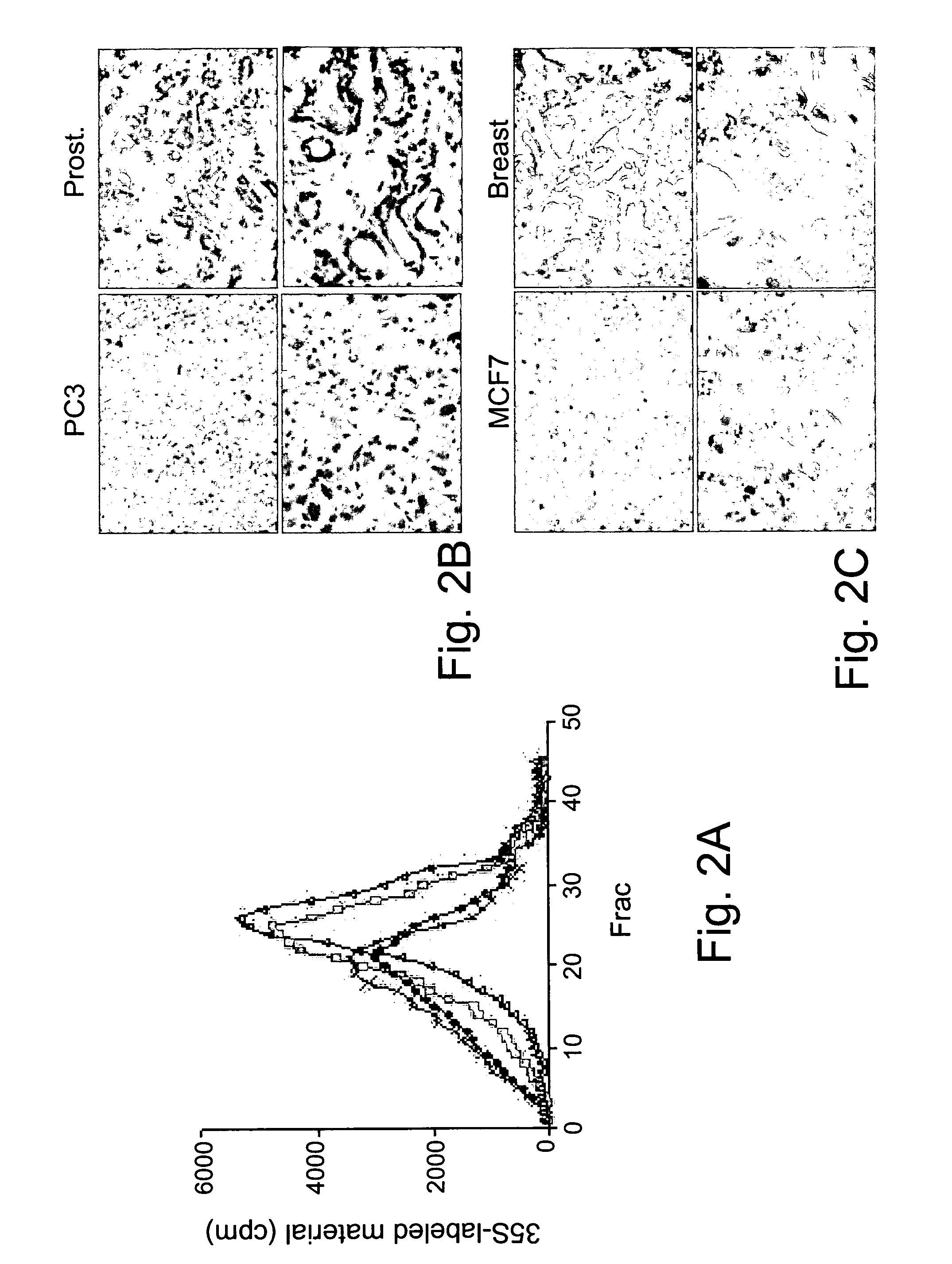Substances directed against a specific sequence essential for heparanase catalytic activity and uses thereof as heparanase inhibitors
a specific sequence and catalytic activity technology, applied in the direction of peptides, drug compositions, peptides, etc., can solve the problem that heparanase antibodies cannot distinguish between the latent 65 kda, heparanase precursor and the active enzyme of 50 kda, and achieve the effect of inhibiting the catalytic activity of heparanase glycosidas
- Summary
- Abstract
- Description
- Claims
- Application Information
AI Technical Summary
Benefits of technology
Problems solved by technology
Method used
Image
Examples
example 1
[0317]Antibody #733 Raised Against the N-Terminus 14 Amino Acid Sequence of the 50 kd Heparanase Subunit, Preferentially Recognizes the 50 kDa Active Heparanase Form
[0318]Heparanase is synthesized as a ˜65 kDa non-active precursor that is subsequently processed into 8 kDa and 50 kDa subunits that heterodimerize to form an active enzyme [Fairbanks (1999) ibid.; Levy-Adam (2003) ibid.; McKenzie (2003) ibid.].
[0319]The inventors have previously characterized an antibody (#810) directed against a peptide located at the C-terminus of the 8 kDa heparanase subunit, that preferentially recognizes the 8 kDa fragment as compared to the 65 kDa heparanase precursor [Levy-Adam (2003) ibid.]. In order to better characterize the cellular distribution of the heparanase subunits, this approach was further utilized and an antibody was raised against a peptide located at the N-terminus of the 50 kDa heparanase subunit. Indeed, as shown by FIG. 1A (733), the antibody that was prepared and designated #7...
example 2
Differential Localization of Heparanase Forms and Heparanase Lysosomal Processing as Reveled by the #733 Antibody
[0322]Having demonstrated the ability of antibody #733 to specifically react with heparanase in immunohistochemistry analysis, xenograft tumor sections derived from prostate PC3 and breast MCF7 cells, two cell lines that exhibit moderate and low heparanase activity profiles in vitro, were stained (FIG. 2A). These xenograft sections were compared with heparanase expression in human prostate and breast tumor biopsies (FIG. 2B-C). Antibody #733 was able to detect heparanase expression in PC3 (FIG. 2B, a-b) and MCF 7 (FIG. 2C, a-b) xenografts, as well as in prostate (FIG. 2B, c-d) and breast (FIG. 2C, c-d) biopsy specimens. Thus, although PC3 and MCF 7 cell lines exhibit relatively low heparanase activity in vitro (FIG. 2A) and undetectable levels of heparanase in immunoblot analysis and immunofluorescence staining (data not shown), heparanase expression appeared to be up-reg...
example 3
[0326]Antibody #733, Specific for the N-Terminus Region of the 50 Kd Subunit of Heparanase, Inhibits Heparanase Enzymatic Activity
[0327]The preferential recognition by antibody #733 of the processed 50 kDa heparanase as compared to the non-processed 65 kDa form (FIG. 1A) suggests that the N-terminus of the 50 kDa protein undergoes conformational changes upon heparanase processing, exposing an epitope that is not present in the 65 kDa heparanase precursor. Although this region is not considered to be part of the heparanase active site [Hulett, M. D. et al., Biochemistry 39, 15659-15667 (2000)], it may well be involved in a three-dimensional organization assumed by the 50 kDa heparanase upon processing, and that is necessary for enzymatic activity. To test this hypothesis, purified heparanase was incubated with affinity-purified antibody #733 or control rabbit IgG, and enzymatic activity was determined. As shown in FIG. 6A, antibody #733 significantly inhibited heparanase enzymatic ac...
PUM
| Property | Measurement | Unit |
|---|---|---|
| pH | aaaaa | aaaaa |
| half life | aaaaa | aaaaa |
| half life | aaaaa | aaaaa |
Abstract
Description
Claims
Application Information
 Login to View More
Login to View More - R&D
- Intellectual Property
- Life Sciences
- Materials
- Tech Scout
- Unparalleled Data Quality
- Higher Quality Content
- 60% Fewer Hallucinations
Browse by: Latest US Patents, China's latest patents, Technical Efficacy Thesaurus, Application Domain, Technology Topic, Popular Technical Reports.
© 2025 PatSnap. All rights reserved.Legal|Privacy policy|Modern Slavery Act Transparency Statement|Sitemap|About US| Contact US: help@patsnap.com



